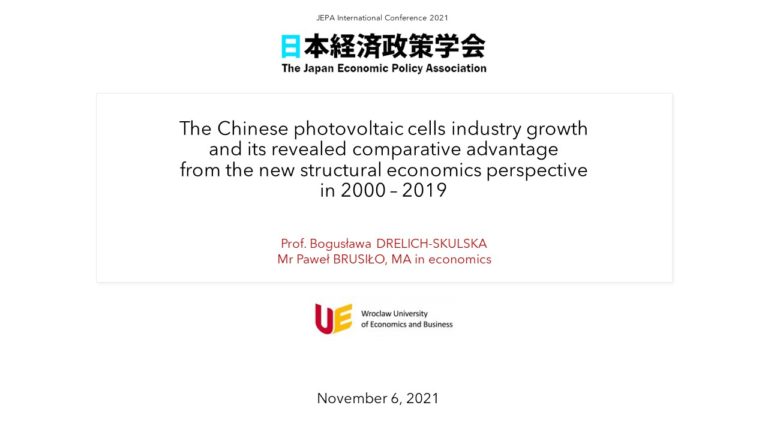JOINT CONFERENCE PRESENTATION WITH PROFESSOR BOGUSŁAWA DRELICH-SKULSKA AT THE UNIVERSITY OF TOKYO, NOVEMBER 6-7, 2021
Our research presented a review of the new structural economics (NSE) assumptions in the context of an impressive development of the Chinese photovoltaic cells industry in 2000-2019. Furthermore, we aimed to study and illustrate the impact of the industrial policy measures and the implemented state interventions on the development of the studied leading-edge industry from the perspective of revealed comparative advantage considering the theoretical assumptions of the NSE. The methods applied in this research, besides the literature review and desk research, involved calculations of Balassa’s RCA index and analysis of the exports volumes in the studied period based on the data sourced from the United Nations COMTRADE database.
The research results showed that the state interventions towards the development of the Chinese photovoltaic cells industry match the assumptions of the new structural economics. The industrial policy and strategies implemented by the Chinese authorities significantly evolved over the studied period, showing a wide range of instruments and measures that translated to the dynamic growth of this leading-edge industry. The multidimensional approach of the authorities towards photovoltaics resulted in the increasing role of solar power in the Chinese energy mix. For instance, the electricity generation from photovoltaics in 2009 reached 0,4 billion kWh and accounted only for 0,83% of all energy generated from renewable energy sources (excluding hydropower). In 2019, the share of solar power vastly increased to 43,66% and reached 224 billion kWh. Moreover, this industry has revealed a significant comparative advantage. The RCA index of the studied industry increased from 0.61977548 up to 3.04388398 within the years 2000-2019, resulting in a high trade specialization in photovoltaic cells on a global scale. In addition, by 2019, the Chinese photovoltaic cells industry had been an inimitable global leader in terms of capacity, production, export and innovative technology implementation.
By comparing the new structural economics postulates and the Chinese industrial policy towards photovoltaics, the research revealed the substantial role of state interventions in the process of shaping the capital-intensive development of the technologically advanced industries related to renewable energy sources. Research findings provide a starting point for discussion and further research that should consider structural changes that occurred within the studied industry as well as how the Chinese photovoltaic cells industry growth impacted the global value chains and global supply chains. Furthermore, the future study should compare the industrial policy towards analyzed industry in Japan and the other Asia-Pacific countries. To our best knowledge, the Chinese photovoltaic cells industry has never been studied in the context of revealed comparative advantage index and simultaneously new structural economics. The research results and the exemplification of this analyzed policy-driven industry blazes the trail for the countries that consider following the Chinese development path in developing national leading-edge industries related to renewable energy sources, especially solar power.
